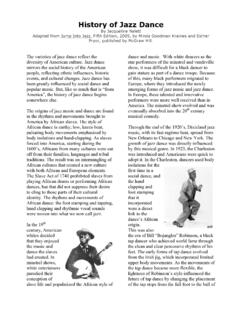Transcription of Dante’s Inferno: Critical Reception and Influence
1 Dante sInferno: Critical Reception and InfluenceDavid LummusDante and theDivine Comedyhave had a profound Influence on theproduction of literature and the practice of literary criticism acrossthe Western world since the moment theComedywas first read. Al-though critics and commentators normally address the work as awhole, the first canticle, inferno , is the part that has met with the mostfervent Critical response. The modern epoch has found in it both amirror with which it might examine the many vices and perversionsthat define it and an obscure tapestry of almost fundamentalist pun-ishments that are entirely alien to it.
2 From Ezra Pound, T. S. Eliot, andOsip Mandelstam in the early twentieth century to Seamus Heaney,W. S. Merwin, and Robert Pinsky at century s end, modern poets ofevery bent have been drawn to theInfernoand to the other two canti-cles of theComedyas an example of poetry s world-creating powerand of a single poet s transcendence of his own spiritual, existential,and political them Dante was and is an example of how apoet can engage with the world and reform it, not just represent it,through the power of the poetic imagination.
3 In order to understandhow Dante and his poem have been received by critics and poets in thetwentieth and twenty-first centuries, we must glance however curso-rily at the seven-hundred-year Critical tradition that has formed thehallowed academic institution of Dante studies. In this way, we cancome to see the networks of understanding that bind Dante criticismacross its story of the Critical response to Dante s poem begins with Dantehimself (or with someone writing under Dante s name). Upon com-pleting the last canticle of theComedyhe wrote a letter to his patron inVerona, Cangrande della Scala, in which he dedicated theParadisotohim and then, as a reader of his own poem, explained its subject most of the epistle is dedicated to the interpreta- Critical Reception and Influence63tion ofParadiso, for our purposes he introduces several concepts im-portant for the history of criticism of the poem as a whole and for liter-ary criticism in general.
4 The structure of the epistle is modeled on theschema that was used in Dante s time for writing prologues to classicaltexts (theaccessus ad auctores), which suggests that his work, thoughin the vernacular, deserved and demanded the same kind of attention asif it had been written in Latin. Also, Dante importantly illustrates themeaning of the poem by applying the fourfold system of allegory nor-mally reserved for interpretation of the Bible. According to this systemtexts may have several meanings (Dante uses the word polysemous ):the literal or historical, the allegorical (regarding the life of Christ), themoral or tropological (regarding the actions of the individual soul inthis life), and the anagogical (regarding the life of the soul to come).
5 Asan example of this interpretive method, Dante briefly analyzes the firsttwo lines of Psalm 113, When Israel went out of Egypt, 3obliquelyopening up the possibility of comparing his own poem and personalexperience with these biblical verses and the narrative of transcen-dence through exile that they interpretation of the poem s title and subject, however, is ratherunimaginative and does not fully account for the poem s radical nov-elty. Dante explains that the poem is a comedy because the subjectmatter, at the beginning it is horrible and foul, as being Hell; but at theclose it is happy, desirable, and pleasing, as being Paradise and be-cause the style is unstudied and lowly.
6 4 The subject, he writes, is lit-erally the state of souls after death, but allegorically it is man ac-cording as by his merits or demerits in the exercise of his free will he isdeserving of reward or punishment by justice. 5 The allegorical sub-ject of theInferno, then, would be those who deserve punishment byexercising poorly their free will. Furthermore, in the tradition of mostmedieval commentaries on Latin literature, Dante and those who fol-low him describe the work as belonging to the field of ethics, whichgives even its most abstract moments a practical purpose.
7 In sum,whether penned by Dante or not, this epistle establishes theComedyas64 Critical Insightsa work of poetic theology whose truth as a fiction lies somewhere be-tween the Bible and first commentaries on theComedywere written in the periodimmediately following Dante s death, beginning with his own sons,Jacopo and Pietro. These commentaries for the most part sought to re-deem the work s unorthodoxy by explaining it allegorically. A genera-tion after Dante, the contributions of Giovanni Boccaccio (1313-75)founded the cult of Dante and created the institution of Dante studiesthat spans the globe today.
8 The famed author of theDecameronwrotethe first biography of Dante (theTrattatello in laude di Dante, or trea-tise in praise of Dante ; translated into English in 1898 asLife ofDante) and gave a series of public lectures (theEsposizioni sopra laCommedia di Dante, or expositions on Dante sComedy ) meant toelucidate the literal and allegorical meanings of the that the poem could have a profound practical effect onthe Florentine community, thecomuneof Florence paid Boccaccio tolecture on the poem in the church of Santo Stefano in Badia.
9 The firstofficiallector Dantis, Boccaccio was able to speak only about the firstseventeen cantos ofInfernobetween October 1373 and January 1374before falling , like other medieval and Renaissance in-terpreters of the poem, considered Dante apoeta theologus, or poettheologian, whose art was able to probe major philosophical questionsas well as treatises on theology or the interpretation of Scripture. Evenmore, he treated Dante as the heir both to the biblical poets David andSolomon as a newscriba Dei, or scribe of God and to the classi-cal bards Homer and Vergil, creating for Dante a persona that is some-where between prophet and poet.
10 Whereas most of the early commen-tators were interested in the allegorical meanings alone, Boccacciofocused in hisEsposizionion the literal meaning of the text because hethought that the uneducated would be less likely to misunderstand itsallegorical message if they understood it literally first. For Boccaccio,as for Dante before him, the fact that the poem was written in vernacu-lar was key to its fulfilling a practical purpose. By the end of the fif- Critical Reception and Influence65teenth century, after numerous commentaries and lives of Dante hadbeen written, theComedy s status as a classic had been secured, andDante had become a key figure in the establishment of a Renaissance Florence, Cristoforo Landino (1424-98)


